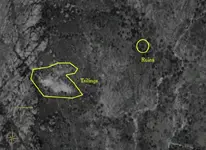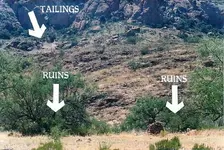I don't believe Colonel Hodge was questioning his own competancy on the question of Jesuits or indian and Mexican labor.
The first part of that very sentence/paragraph states: "A full description of the different mineral belts of the country, of the locations made, and of the mines already opened, would fill volumes, and therefore, will not be attempted in this work. ..... An outline and partial description alone can be given, leaving the subject to be fullly written up in the future by some one having more time and more competant to the task."
I read that to mean Col. Hodge was talking about the tremendous "volumes" it would take to describe the mines and locations and methods, not the Jesuits or the labor issue. Hodge was saying he didn't want to include such a volume of that information in his work and was leaving it for someone else to take on that task. He was not calling himself incompetant. In fact, Col. Hodge does not mention the Jesuits or the indians or the labor issue until the next sentence / paragraph, so it would be unlikely to say he was talking about Jesuits in that particular passage.
Colonel Hodge was one of the most respected Southwest Historians of his time. A testimonial to his published work includes some fairly important and able citizens and historians themselves. Much of what we know today about the Southwest/Arizona history comes from these gentlemen. This testimonial appears in the Arizona Historical Society and is included in his work on this subject. Many of the most prominant Arizona and Southwest historians used Colonel Hodges research and work in their own research and histories. Thomas Farish, James McClintock, and James Barney to site just a few.
DURING the years 1874, 1875, and 1876, Col. H. C. Hodge has made a thorough tour and exploration of Arizona. His articles on the country, descriptive of its mineral, agricultural, grazing, and other resources, and of its climate, scenery, and prehistoric ruins, published in different sections of the Union, have been truthful, and more full and complete than any heretofore given the public, and believing him to be an honest, truthful, and reliable gentleman, we commend him and his writings and lectures to the people of the United States, with the assurance that full confidence may be given to his reports on Arizona.
ARIZONA, October, 1876.
(Signed.)
A. P. K. SAFFORD, Governor A. T.
H. S. STEVENS, Delegate in Congress from A. T.
AUGUST V. KAUTZ, Commanding Military Department of A. T.
F. H. GOODWIN, United States Marshal of A. T.
G. S. VOSBURG, Adjutant General of A. T.
COLES BASHFORD, late Secretary of A. T.
P. R. BRADY, member of Council, A. T.
A. E. DAVIS, member of Council, A. T.
J. P. HARGRAVE, member of Council, A. T.
JOHN G. CAMPBELL, member of Council, A. T.
J. M. REDONDO, member of Council, A. T.
JOHN T. ALSOP, speaker House of Representatives, A. T.
A. L. MOELLER, member House of R., A. T.
C. P. HEAD, member House of R., A. T.
S. R. DE LONG, member House of R., A. T.
SAMUEL PURDY, JR., member House of R., A. T.
JAMES P. BULL, member House of R., A. T.
GIDEON BROOKS, member House of R., A. T.
THOMAS CARDIS, United States Collector Internal Revenue, A. T.
P. R. TULLY, Territorial Treasurer, A. T.
LEVI RUGGLES, Register United States Land Office, Florence, A. T.
M. S. STILES, Receiver Land Office and United States Disbursing Agent, Florence, A. T.
C. H. BRINLEY, United States Deputy Collector of Customs, Yuma, A. T.
T. J. BUTLER, Editor “Miner,” Prescott, A. T. WM. J. BERRY, Editor “Sentinel,” Yuma, A. T.
JOHN W. LEONARD, Assistant Editor “Enterprise,” Prescott, A. T.
BRIGGS GOODRICH, District Attorney, First District, A. T.
H. B. SUMMERS, District Attorney, Pinal County, A. T.
H. H. CARTER, Judge of Probate, Yavapai County, A. T.
H. N. ALEXANDER, Judge of Probate, Yuma County, A. T.
WILLIAM A. HANCOCK, District Attorney, Maricopa County, A. T.
GEORGE D. KENDALL, Mayor of Prescott, A. T.
C. A. LUKE, Ex-mayor of Prescott, A. T.
EDWARD F. BOWERS, Sheriff, Yavapai County, A. T.
WILLIAM WILKERSON, Clerk of Court and Recorder, Yavapai County, A. T.
H. C. MEADOR, Deputy, Yavapai County, A. T.
S. W. CARPENTER, Recorder, Pima County, A. T.
JOHN J. DIVINE, Recorder, Pinal County, A. T.
O. F. TOWNSEND, Recorder, Yuma County, A. T.
JAY G. KELLY, Assayer, Prescott, A. T.
BLAKE & COMPANY, Prescott, A. T.



 If you only want positive opinions, it's best to keep your story private.
If you only want positive opinions, it's best to keep your story private.




 Wonder why that bit of the legend did not catch on.
Wonder why that bit of the legend did not catch on.